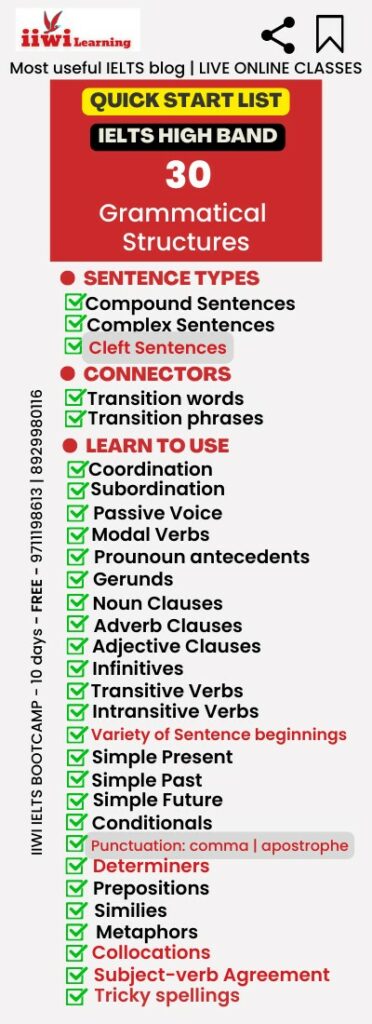30 IELTS grammar structures to make huge difference to Grammatical Range • IIWI
Nothing wrong with the conventional method of doing definitions, examples, and exercises for improving grammar. BUT! How much YOUR GRAMMAR PRACTICE is in tune with YOUR ERRORS, is the main factor that decides how much you REALLY improved. In other words, what was your percentage improvement?
I bring to you 30 key points for building an IELTS high-band grammatical range that transforms your IELTS performance to the next level. This blog post is an IELTS band score BOOSTER for Grammatical Range.
IELTS Preparation blog by IIWI is the most useful IELTS blog because I write posts on doubts/questions students ask in the classes.
I try to give you the success mantra along with reasons why you should follow it & the results it will give you.
So, let’s jump right in!
TABLE OF CONTENT
Tip #1: Why NOT working on grammatical range and accuracy gives you a low IELTS band score?
Tip #2: Maximum improvement with minimum efforts method
Fact #3: 2 MOST COMMON REASONS for Low Grammatical Range IELTS band score
Fact #4: 3 Reasons why BE becomes very limiting as the main verb (linguistic reasons)
Tip #5: Quick List 30 Grammar Structures
Tip #6: 2 least used tenses
Tip #7: 3-phase Study Plan for improving grammatical range and accuracy.
Tip #8: Pattern of Low-scoring & High-Scoring responses (GRA)
Tip #1. Why not working on grammatical range and accuracy give you a low IELTS band score?
GRA (Grammatical range & accuracy) carries 25% weightage of the total IELTS score. If you do not build the required grammatical range along with grammatical accuracy, you won’t be able to get beyond Low Band 5.
Why?
Simply because you will fall under the Band 5 Grammatical Range & Accuracy Description wherein a test taker:
– uses only a limited range of structures
– attempts complex sentences but these tend to be less accurate than simple sentences
– may make frequent grammatical errors and punctuation may be faulty: errors can cause some difficulty for the reader.
Tip #2. Maximum improvement with minimum efforts way
It does not take months but only days to build up a grammatical range for a high band if you have these 4 things –
#1 A commitment to improving (DON’T look for great results with fewer efforts – you will only be fooling yourself)
#2 A complete list of ADVANCED grammatical structures
#4 DAILY practice
#5 Side by side EVALUATION and MISTAKE REMOVAL
Get started with the IIWI Quick Start List of Grammatical Structures.
One ADVANCED Grammatical Structure a Day and you will improve by one band within 10 days.
It’s easy! It’s do-able!
Fact #3. 2 MOST COMMON REASONS for Low-scoring Grammatical Range
Reason 1: Relying mainly on simple sentence patterns (subject + verb).
Reason 2: Redundancy means using words unnecessarily or repetition of words.
Reason 1: Relying mainly on simple sentence patterns (subject + verb)
Overusing the BE verb as the main verb of a sentence (am, is, are, was, were). I’m not saying it is wrong or always bad to use BE as a main verb. Even native speakers tend to use it quite a lot. The point is, it leads to a lot of repetition. So simply, actively trying to limit BE verb use can be a useful language development exercise.
Fact #4. 3 Reasons why BE becomes very limiting as the main verb (linguistic reasons)
Reason1: You lose out on the descriptive possibilities of other verbs
Reason 2: Your sentences tend to follow one pattern: Subject/compliment.
Reason 3: Overuse of BE does not permit adverb or adverbial phrases/clauses, as a result of which to you repeat nouns and adjectives for description.
So instead of using the most common and same kind of sentence patterns, you must work at increasing the range of your sentence patterns. So, here is the most valuable list to get you started.
This is a Self Improvement Grammar List I’ve created from my experience of teaching students over 30 years. You can trust this list.
This list includes grammatical structures that YOU WILL use most frequently.
Here it is!
There are some grammatical structures not included in this list because they are the least used or the least cause of common errors. No point in studying least-used grammar structures.
Tip #6. Example: 2 least used tenses
#1 Past Perfect Progressive
#2 Future Perfect Progressive
You see that’s not the language we need to use commonly.
High score responses for grammatical range and accuracy use a variety of sentence patterns and grammatical structures properly and without errors.
So, get started towards scoring Band 6 to 8 easily.
Tip #7. 3-phase Study Plan for improving grammatical range and accuracy.
Phase 1: Master these 30 structures – One a day – complete the entire list in about a month.
Phase 2: Take up IELTS Speaking mock tests and evaluate how well you use these structures
Phase 3: Take up IELTS Writing Task 2 and evaluate how well you use these structures
The most essential thing for improvement in these 3 phases is the evaluation of your performance.
Besides, assessing your comfortableness with using these 30 grammatical structures you must also watch out for the most common mistakes generally made.
Tip#8. The pattern of Low score responses for grammatical range and accuracy
Make regular “systematic” errors.
Example – Let’s say the student has a problem with articles – a. and the
The student will make the same article mistakes in 10 to 15 places in a text. Every time he/she will repeat same mistake. In other words, they are repeated errors of the same grammatical structure.
Pattern of High score responses for grammatical range and accuracy
Will have occasional grammar mistakes! Most of the grammatical structures used by the student will be correct. Making a few mistakes doesn’t mean that that the score will be low. However, the mistakes should be scarce, and definitely not of the basic level. Mistakes in highly advanced grammar structures will not affect the score so much.
If you have enough time before your exam (a few months or more), think about taking a class and investing in getting yourself evaluated for mistake removal. You can book a demo with IIWI.
In addition to Grammatical Range and Accuracy, the official IELTS Speaking rubric also calculates scores based on fluency, pronunciation, and lexical resource (word use).Check out IIWI tutorials for those other three aspects of the rubric too.
Conclusion
Mastering Grammatical structures are the key to an IELTS high score. You should understand the difference between low-scoring responses and high-scoring responses for grammatical range and accuracy.
You must check the grammatical range and accuracy of your speaking and writing responses in IELTS Speaking Mock Test & IELTS Writing Task 2. Get yourself evaluated by an IELTS Expert for an accurate evaluation on the lines of IELTS Speaking Rubric and IELTS Writing Rubric.
Use the 30 grammar structures checklist for improving you grammar range and after completing your practice get yourself evaluated again.
You will have a sure-shot improvement by at least one band. Simply because you practiced on the most frequently used grammatical structures and took the feedback to remove your mistakes.
I’m sure you’ve realized how much work you have at hand!
Get going without delay!
You can follow my blog posts for grammatical structures. Any questions or doubts just pick up the phone and call 9711198613 |8929980116. I’m just a click away.

Founder- IIWI Learning IELTS 8+ Coach, 30 yrs exp.|Author|Blogger







Leave a Reply